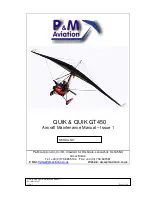
North&Wing&S,LSA&Maintenance&Manual&
Model:&Sport&X2&582&
Issue 3.2
Printed: July 16 2017
Page 25
North Wing Annual and 100-hour Inspection Check List
M-Pulse 15 Wing
Pass Fail Perform the following checks on the wing
For wing inspection it will be necessary to remove the wing from the trike
and perform checks 1 – 15 with the sail on the frame. Then the sail should
be removed from the frame to complete the wing inspection, items 16 &
17.
1.
!
Wing fabric for tears greater than 1” long (25mm), are within 1“ of a
seam, run off the edge of the material, and abrasions that have
weakened the fabric. These require professional repair. See Wing
Repair section.
2.
!
Fabric for tears smaller than 1” that are not within 1” of a seam and do
not run off the edge of the material. These can be repaired with sail
repair tape.
3.
!
Tip webbing or any breaks or tears in webbing
4.
!
All zippers for smooth operation, full range operation, secure inter-
locking at start end, and sound stitching
5.
!
Test fabric (top side of wing) for strength (UV damage) using a UV test
panel from the Mustang III top surface or a Bettsometer. Annual
testing with a Bettsometer is recommended for wings exposed to UV
on a frequent basis or typically long exposure periods. Use a 1.2 mm
diameter needle. Check tensioned sail for 1360 grams pulling upward.
6.
!
Remove all ribs and check for damage and symmetry against the
template provided by North Wing
7.
!
Rib tensioning cords for wear and proper tension
8.
!
Wing strut attachment bolts tightened to “snug fit” (See torque table
Section 2) and no visible wear on attachment pins
9.
!
Front and rear pitch control wires for stretch of 1/8” or more (See
Specifications for factory length), kinks, broken strands, corrosion,
slipped position at nico press, elongation or kinks in thimbles, and
hardware attachments
10.
!
Pull back tensioning cable and pulley assembly for broken strands,
kinked thimbles, worn attachment hardware and bolts.
11.
!
Cross bar connection plate bolts not worn and safety wired
12.
!
Sprogs for firm attachment and any bends. Check for bent ball joint.
13.
!
Nose plate bolts and swan hook tightened to “snug fit” (See torque
table)
14.
!
Nose cone Velcro grip is not weak
15.
!
Position lights (if applicable) firmly attached
16.
!
Leading edges, keel tube, cross bars, down tubes, and base tube for
dents, bends, corrosion, or wear at bolt holes
17.
!
All stitching for breaks and separation of sewn material













































